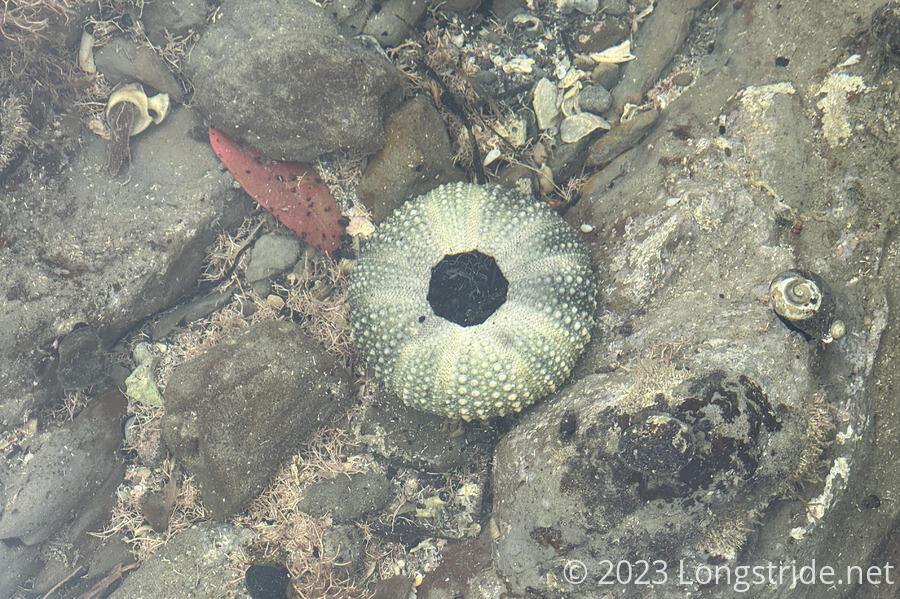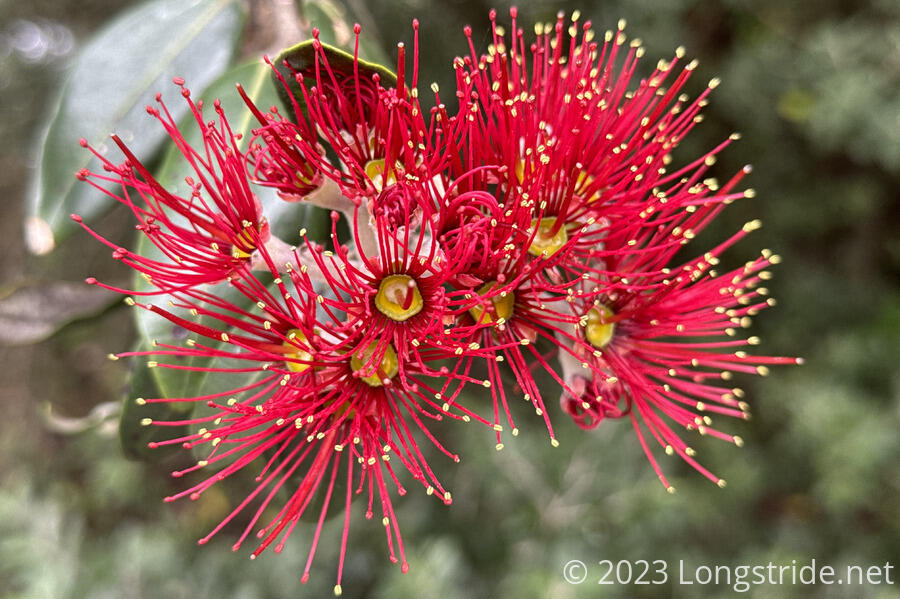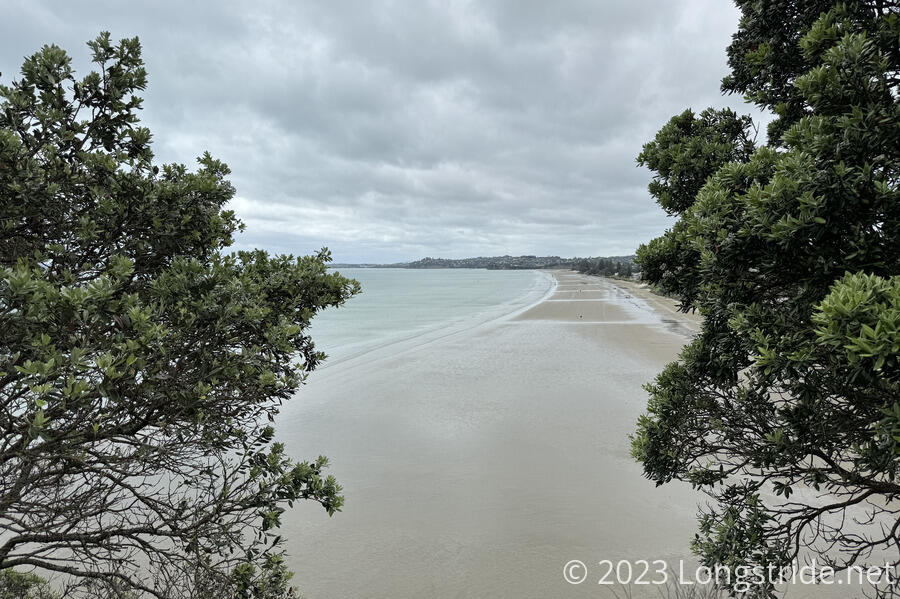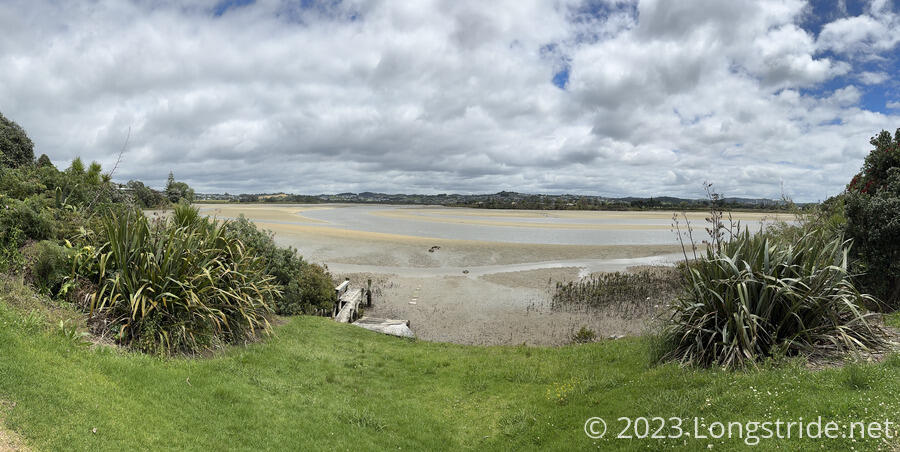Returning to Waiwera, we resumed our hike towards Auckland, crossing a number of interesting beaches and passing through a few small towns on our way to Dacre Point, where a long water crossing awaits us tomorrow.
As planned, we left CareFree’s apartment, walked down towards the Auckland waterfront, and caught a bus back to Waiwera. We got back to the trail around 9 am, right around the start of low tide. It was overcast, but not raining, a significant improvement over the weather from when we were here two days ago.
A little bit more road walking brought us to Waiwera Beach. With the tide out, the sandy beach quickly gave way to a long, rocky expanse filled with small rocks, parts of mussel shells glued to the rocks, and lots of seaweed. The sea bed itself was rows of terraced, curved lines, unique of the beaches we’ve been to so far.
The beach was rather rough to walk on, being uneven rock. There were plenty of small tidal pools, which also meant plenty of chances to get my feet wet. (I was mostly successful at keeping my feet dry, though I did get my feet slightly wet at one place where the ocean came right up to some tall rocks, and there was no easy way around while also staying dry.)
We passed a few locals this morning, including a couple fishermen, and divers looking for sea urchins. Shortly after passing them, I found a sea urchin of my own, under a few inches of water.
The “trail” continued along the coast, with high cliffs. Some rather nice houses were built atop the cliffs, and at least a few looked like they might be in distress if the cliffs erode further. This is a clear problem closer to Auckland: there are a lot of high cliffs lining the coast, and a lot of (expensive) homes built entirely too close to the edge. A few small caves added to the uniqueness of the area.
There were also a fair number of Pohutukawa trees, notable for their red blossoms. They are hardy cliff-dwellers, though are endangered by (non-native) possums, which strip trees of leaves while browsing for food.
Leaving Waiwera Beach, a brief interlude on road brought us to the sandy Ōrewa Beach. There were a fair number of people out on the beach walking, probably the most so far of any beach I’ve been to so far in New Zealand. There was also a few surfing lessons, the largest of which had maybe 30 children participating.
It was still overcast, as we started to leave the beach, the sun started to poke its way through the clouds, and we saw a little bit of blue sky. Two beaches down, we took that as a cue to find a place to have a snack, and settled on the Driftwood Cafe, attached to an art gallery, that had some fantastic muffins.
Leaving the cafe, we followed a cycle path for a while, following the Ōrewa River estuary upstream. Not yet at high tide, there was still a lot of exposed ground. Mangroves (and mud) lined the edge of the river.
The cycle path eventually brought us to a road, in Silverdale, and we followed the road through town. Passing by a private school whose children were at recess, a couple of school kids yelled out “hikers! hikers!” and waved at us. (We weren’t expecting that, but also, “tramping” and “trampers” are the terms generally used in New Zealand for this activity, so it was curious they didn’t call that out at us.)
We passed a convenience store, got some more ice cream, and took a short break.
Leaving Silverdale, the trail took us along a relatively busy road with a reasonably wide shoulder, and then turned off onto a much quieter road. That road didn’t have as much of a shoulder, and had a number of blind curves, but it wasn’t the worst road we’ve walked. The residents seemed pretty friendly, and two offered us rides down the road. (We declined.)
The road eventually brought us to the Okura Bush Walkway, with a restroom and water fountain just before the entrance. We filled up on water there so as not to have to worry about filtering from an estuary when we stopped.
The “walkway” went through wetlands, and with tide still in, it was a little bit of a chore to avoid getting our feet wet. Eventually, the trail forked, with the low-tide path going around a submerged beach, and the high-tide trail (which we took) climbing a hill. That gave us a good vantage point of Dacre Point, where we’ll start our crossing of the Ōkura River tomorrow morning at low tide.
With the tide still in, we had to take our boots off to cross a small stream in front of the historic Dacre Cottage, a small brick building a short distance from the creek and river.
We set up our tent on the cut grass on the cottage’s grounds, and watched the tide go out, which it did pretty quickly to reveal a large mud flat. Low tide is half an hour after sunset, which is too late to consider doing tonight, since we’d also have to find a campsite, and it doesn’t seem there’s much opportunity to camp on the other side of the estuary.
After we set up our tent, we had a conversation with a local who came by, who appeared to be a caretaker for the cottage. He gave us some notes on the crossing (which we already knew). I asked him about the possum traps we saw, and he said they’re checked weekly, so we don’t need to report them. (He also mentioned how one week last year he went hunting and shot 300 possums. They seem to be quite the menace.)
We expected to see more hikers at the cottage, since it’s an obvious camping spot at a bottleneck, but we only saw three others, who arrived around 7:30, after I’d already gotten into our tent.
Tomorrow will be a lazy morning, since we can’t leave to cross until around 9:30. Then we have a long day to hike the rest of the way into Auckland and back to CareFree’s apartment.







